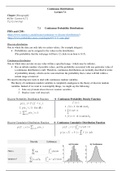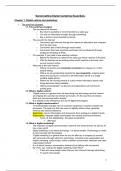n
Study Pack by Lucy
Barnes
The gradient (slope) of a function is
known as the ‘rate of change’. For B
example, the gradient can tell us how
quickly Y increases, as X increases.
We already know how to calculate the
gradient of a linear function (Example
1.1).
Example 1.1: Find the gradient of the
function (shown on the right). A
Solution:
Let point A = (0.25,0.5) and B =
(0.5,1)
change∈ y
Gradient =
change∈ x
(1−0.5)
=
(0.5−0.25)
0.5
=
0.25
=2
This method is perfect when working with linear functions, as shown above. What if the
function isn’t linear? Let’s see y=x 2+2x+1 as an example…
Since the graph is not linear, the gradient isn’t
P2 constant, it changes depending on where we look.
L1 For example, if we draw a tangent at (x=-2), this
will have a different slope than the tangent at
(x=-0.5).
So how can we work out the gradient of the
L2 The gradient of point P1 is the gradient of
the tangent, T at point P1. Let P1 = (-0.5,
P3 0.25).
1) Let’s take the point P1 and connect it to
another point, P2 = (0,1), with line L1. We
can find the gradient, m1, of this line, using
the same method in example 1.1, m1=1.5.
P1 2) Now let’s repeat this process, connecting P1
to an even closer point, P3 = (-0.293,0.5),
with line L2. Now we can find the new
gradient, m2=1.207 (3dp).
T
3) As we get closer and closer to P1, the lines
we draw become more accurate to the
actual tangent at P1. Therefore, to find the
gradient of the tangent at P1, we need to
get extremely close to the point, where the
distance between P1 and Pn is as small as
possible.
1
, yDon’t forget to show
your workings! f(x)
To find the gradient at point (x,f(x)), h
f(x+h) needs to be as small as possible.
We say, ‘h tends to 0’.
The gradient can be calculated as
follows:
change∈ y
Gradient = lim ¿h →0 ¿
change ∈ x
f ( x+ h )−f ( x )
=lim ¿h →0 ¿
( x +h )−x
f ( x+ h )−f (x )
f(x) = lim ¿h →0 ¿
h
This method is differentiation, and the
result is called the derivative.
x dy Δ y
(0,0) x x+h The notation used is f’(x) or / /
h dx Δ x
f ( x+ h )−f (x )
f’(x) = lim ¿h →0
h
¿
Example 1.2: Use the formula to find the derivative of the following:
f(x) = 3x2 + 2x + 4
Here, we can’t substitute h=0 into
Solution: the equation because it’s impossible
to divide by 0.
f ( x+ h )−f ( x )
f’(x)= lim ¿h →0 ¿ We need to substitute the function in
h and simplify as much as we can.
=lim ¿h →0
( 3 ( x+ h )2+ 2 ( x +h ) + 4 ) −( 3 x 2 +2 x+ 4)
¿
h Now we can make h=0 to find the
2
=lim ¿h →0
6 xh+3 h +2 h derivative.
¿
h
=lim ¿h →0 6 x +3 h+2 ¿
f’(x) = 6x + 2
You may hear this method be called “differentiating from first principles”.
Now, we can find the gradient of any point on f(x), just substitute in the corresponding x
value!
At the point (2,20), f’(x) = 6(2) +2
Try these yourself!
1. Prove the following derivatives:
a) f(x) = 4x3 – 2x + 9 -> f’(x) = 12x2 -2
b) f(x) = 5x -> f’(x) = 5
c) f(x) = 1 -> f’(x) = 0
d) f(x) = sinx -> f’(x) = cosx (HINT: USE THE TRIGONOMETRIC IDENTITIES)
Solutions are at the end of the pdf.
2










